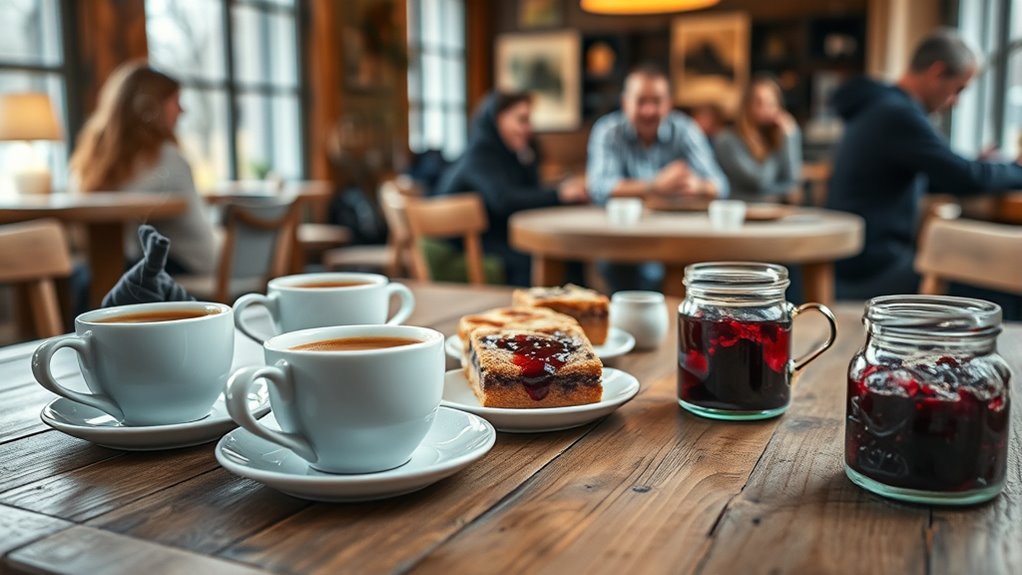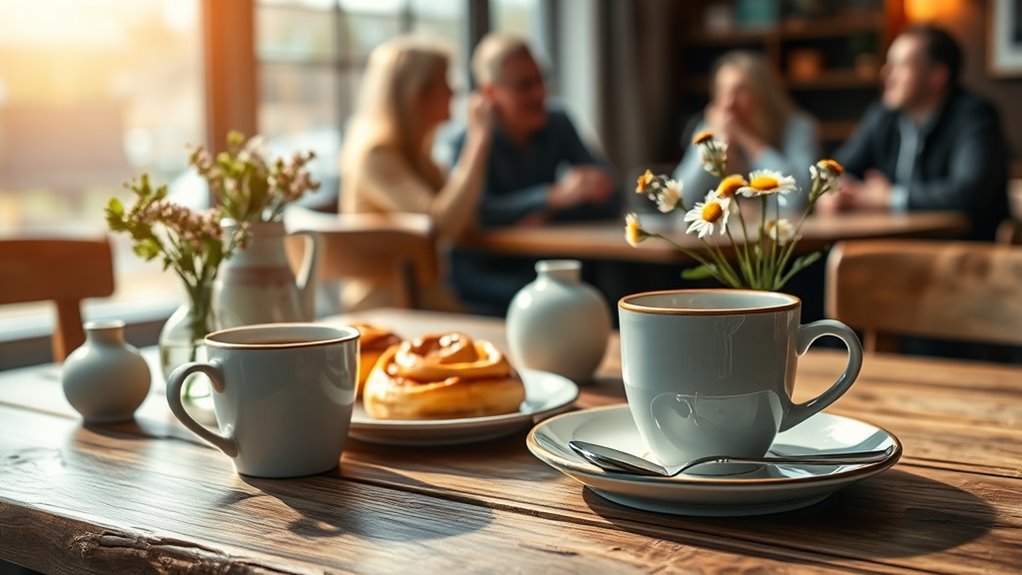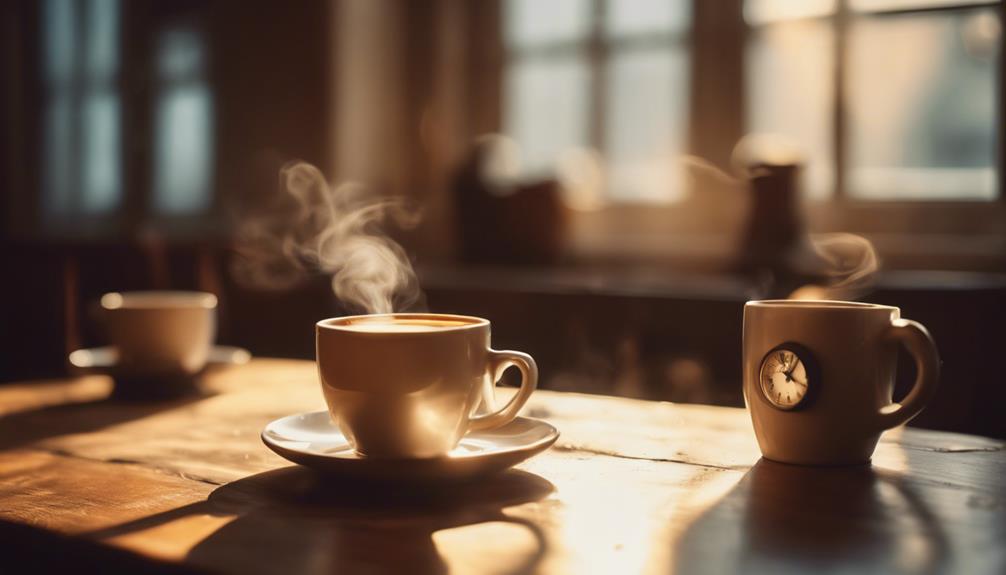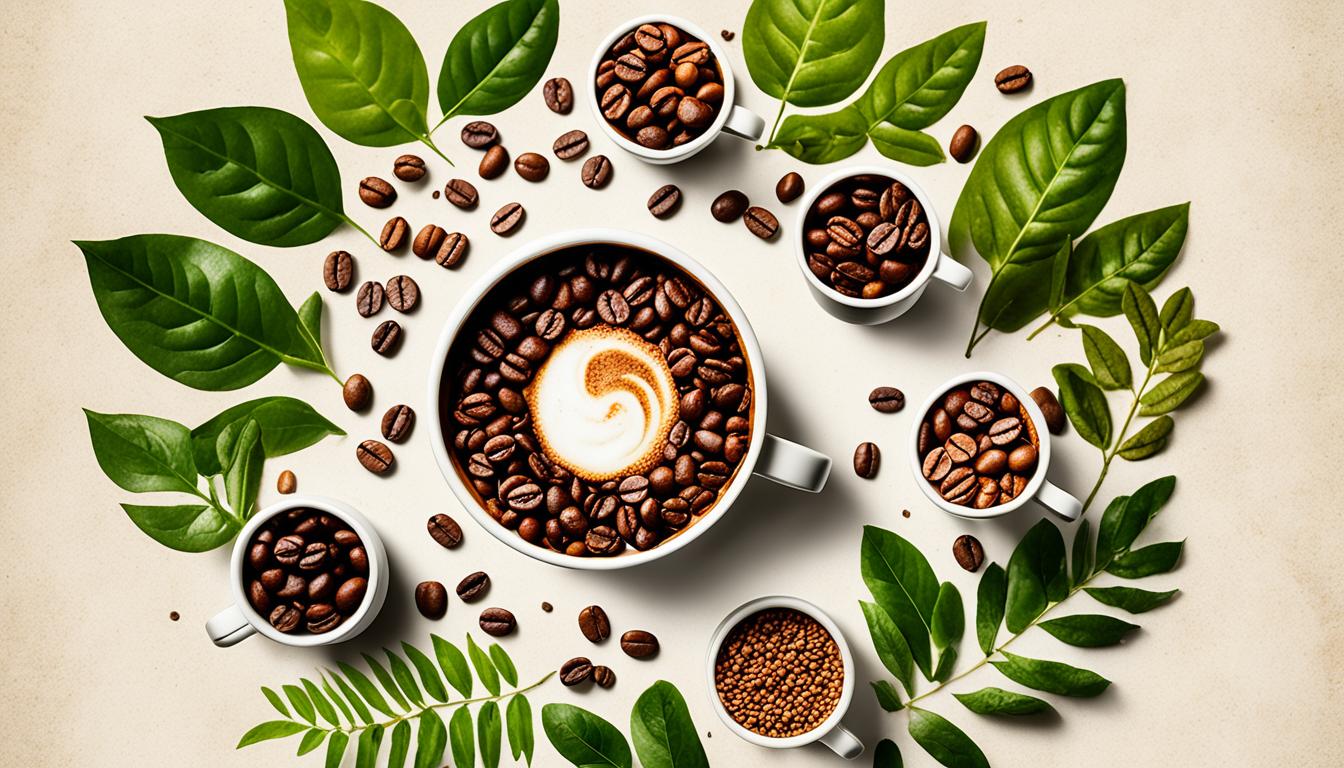The fika phenomenon shows how Swedes pause work and daily life to enjoy coffee and cake together, turning a simple break into a cherished social ritual. It’s more than just a coffee break; it fosters bonds, breaks down hierarchies, and builds a sense of community in workplaces and beyond. This daily or weekly tradition encourages open conversations and strengthens relationships, creating a supportive environment. Keep exploring to discover how fika impacts Swedish culture and work-life balance even further.
Key Takeaways
- Fika is a cultural tradition in Sweden emphasizing social bonding over coffee and pastries during work and daily life.
- It acts as a social ritual that breaks down hierarchies and fosters open communication among colleagues.
- Regular fika breaks strengthen team cohesion, build trust, and create a supportive, inclusive workplace environment.
- Fika promotes work-life balance by encouraging intentional social interaction and taking time to enjoy simple pleasures.
- The practice highlights the importance of informal gatherings for well-being, community, and maintaining a positive cultural identity.

Have you ever wondered why taking a break for coffee and conversation is such a cherished tradition in Sweden? It’s more than just a caffeine fix; it’s a crucial part of the workplace culture that fosters social bonding and strengthens relationships among colleagues. When Swedes gather for fika, they’re doing more than sipping coffee—they’re creating a sense of community and shared identity that permeates their daily routines. This pause in the workday isn’t hurried or superficial; it’s intentional, providing an opportunity to connect, relax, and recharge. Whether in a small office or a large company, fika acts as a social glue, breaking down hierarchies and encouraging open communication. Fika embodies the importance of intentional social interaction in Swedish culture, emphasizing the value of taking time to nurture relationships. In the workplace, fika isn’t just a scheduled break; it’s an unwritten rule that everyone participates in. It signals that taking time to converse and enjoy each other’s company is valued just as much as productivity. During fika, work discussions often blend seamlessly with personal stories, laughter, and casual banter. This environment nurtures social bonding, making colleagues feel more like a team rather than just coworkers. It promotes a sense of belonging and trust, which can boost morale and improve collaboration. Employers recognize that these moments of informal interaction aren’t distractions—they’re investments in a healthier, more cohesive workplace. The social bonding that occurs during fika isn’t limited to the office. It’s embedded in Swedish culture, with many workplaces encouraging daily or weekly fika sessions. This shared ritual helps break down barriers and creates a more inclusive atmosphere. People look forward to these breaks, knowing they’ll have a chance to step away from their tasks and engage in light-hearted conversation. Over time, these interactions build stronger relationships, making the work environment more supportive and enjoyable. Plus, the tradition emphasizes the importance of work-life balance, reminding everyone that taking a moment to enjoy a coffee and a pastry isn’t just a luxury—it’s an essential part of everyday life. Recognizing the significance of cultural traditions like fika can inspire similar practices that promote well-being and community in workplaces worldwide.
Frequently Asked Questions
How Did Fika Originate Historically in Swedish Culture?
You might wonder how fika started in Swedish culture. Historically, it emerged as a tradition centered around coffee rituals, where people take a break to enjoy coffee and often some sweet treats. This social bonding moment became a way to connect with others during the day. Over time, fika transformed into a key part of Swedish life, emphasizing relaxation, conversation, and community, shaping the way they approach daily breaks.
Are There Regional Differences in Fika Customs Across Sweden?
Imagine strolling through Sweden, where each town whispers its own story through local traditions and regional variations in fika. You’ll notice that in coastal areas, fika might include fresh seafood-inspired treats, while inland regions favor hearty pastries. These regional differences deepen your connection to Swedish culture, making each fika experience unique. Embracing these variations, you’ll appreciate how fika reflects the diverse flavors and customs across the country, enriching your journey.
What Are Popular Traditional Swedish Pastries Served During Fika?
During fika, you’ll enjoy Swedish pastry varieties like cinnamon buns, cardamom rolls, and butter cookies. These treats perfectly complement your Fika coffee etiquette, where taking a moment to relax and savor your coffee and pastry is key. You might also find princess cakes or kringles, adding delightful variety. Embracing these traditional pastries helps you experience authentic Swedish culture and enhances your fika break with sweet, satisfying flavors.
How Has Fika Adapted During Modern Work Environments?
Think of fika as a chameleon, adapting seamlessly to modern work life. In today’s digital workplace, you can enjoy remote fika, connecting with colleagues over coffee via video calls. It’s no longer confined to cafes; it’s a flexible pause that fosters team spirit, even from afar. You now take these moments to recharge, bond, and keep Swedish tradition alive, no matter where you work.
Is Fika Practiced Equally Across All Age Groups in Sweden?
You might notice that fika isn’t practiced equally across all age groups in Sweden. Younger people often enjoy fika as a social activity, embracing age diversity and inclusivity, while older generations may see it as a cherished tradition. Regardless of age, fika fosters social bonds, making it a unifying experience. Its adaptability guarantees that everyone, regardless of age, can participate and enjoy the cultural significance behind this beloved custom.
Conclusion
As you embrace the fika tradition, you’re stepping into a warm, bubbling cauldron of Swedish culture. It’s more than just coffee and cake—it’s a gentle pause, a chance to breathe and connect. Imagine each sip and bite weaving you into a cozy tapestry of community and comfort. So, next time you take a fika break, let it be your moment to slow down, savor, and feel the heartbeat of Swedish life pulsing softly beneath your fingertips.








